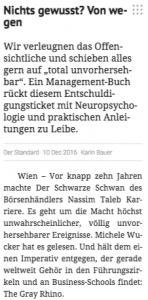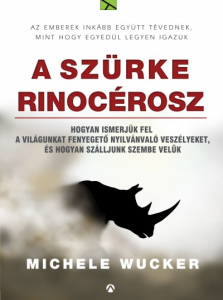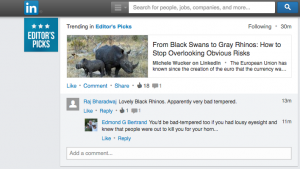 Karin Bauer at the leading Austrian newspaper, Der Standard,
Karin Bauer at the leading Austrian newspaper, Der Standard,
interviewed Michele Wucker about THE GRAY RHINO during Michele’s recent visit to Vienna. You can read the interview HERE (click the “more” button at the end of the article to translate into English; or use your browser’s translate function)
Author: Michele Wucker
BusinessWorld Review: Stay Alert, Act In Time
Elton Sayward reviews THE GRAY RHINO in the December 26, 2016 issue of BusinessWorld, calling it “a must read for the C-Level suite, start-ups and anyone that has been trampled by a gray rhino.”
He applies the framework to his own memories in military situations: “As a US Naval Officer, I saw this first hand on the bridge of ships as officers would delay making a course correction in an obvious close crossing situation with another ship. Officers would have the data at hand from 2-3 different radar sources as well as visually from lookouts, but hesitated to make the call to the Captain to recommend a course change. The fear of looking foolish, making a wrong recommendation, not having the correct information would all play on the officer’s better judgment to take action. This invariably would end up with the officer looking reckless and the Captain coming to the bridge and making the needed course changes in a more complex and urgent situation.”
Take the Gray Rhino Readiness Quiz
Take the Gray Rhino Readiness Quiz and share with your networks.
Click BEGIN THE QUIZ below to get started.
The Gray Rhino Hungarian edition
 THE GRAY RHINO is now available in Hungarian translation via Athenaeum as A szürke rinocérosz: Hogyan ismerjük fel a világunkat fenyeget? nyilvánvaló veszélyeket, és hogyan szálljunk szembe velük
THE GRAY RHINO is now available in Hungarian translation via Athenaeum as A szürke rinocérosz: Hogyan ismerjük fel a világunkat fenyeget? nyilvánvaló veszélyeket, és hogyan szálljunk szembe velük
Click the book cover for more information in Hungarian.
HuffPost: A Creative Outpour Inspired by a Massacre

As Haiti and the Dominican Republic clean up from the aftermath of Hurricane Matthew, this week commemorates another tragedy: the Parsley Massacre, an ethnic cleansing in early October 1937 on the border of the two islands sharing the island of Hispaniola.
In my first book, Why the Cocks Fight: Dominicans, Haitians, and the Struggle for Hispaniola, I wrote about how Dominican soldiers are said to have asked people on the border to pronounce the Spanish word for parsley; if they had trouble trilling the “r,” they were killed.
Rita Dove’s poem, entitled Parsley in reference to that story, powerfully evokes the massacre.
The tragedy has produced other powerful works of literature, film, and creativity.
Farming of Bones is the Haitian-American author Edwidge Danticat’s novel of star-crossed lovers set against the backdrop of the massacre.
More recently, the Dominican-American poet and novelist Julia Alvarez published A Wedding in Haiti, a memoir of her friendship with a young Haitian man named Piti.
I met Julia in 1999 after my publisher sent her an advance copy of Why the Cocks Fight. She sent me a lovely note with a hand-made card with a photograph of a cockfight on the front, beginning a long friendship between two authors who hold a certain island dear in their hearts.
A few years later, Julia and talked over lunch about how sad it was that there had been no “truth commission” or other formal recognition of the victims and survivors of the massacre. We talked about how wonderful it would be to hold a candlelight vigil at the border in their honor. This was before the Internet could bring people together the way it does today, and life (as it has a habit of doing) got in the way of turning the idea into reality.
But in 2011, after the death far too soon of the Dominican-Haitian activist Sonia Pierre, a group of young Dominican- and Haitian-Americans approached us about reviving the idea of a border vigil to both honor Sonia’s memory and memorialize the massacre.
Thus was born Border of Lights, an arts collective driven by rising new voices from the diaspora, that launched in 2012 in the weeks leading up to the 75th anniversary of the massacre. Border of Lights convened performances ofmonologues from the perspectives of victims, survivors, perpetrators, and bystanders, and collected personal narratives that are still hosted on its website.
Border of Lights will hold a Global Vigil this Saturday, October 8, from 8-10pm Eastern Time, with a real time Facebook Q&A about the historical legacy and the way it has played into today’s issues. Border of Lights invites friends around the world to post photos of themselves with candles or other lights to its Facebookand Twitter accounts with the hashtag #BeLights.
From October 7-9, Border of Lights volunteers and partners will hold a vigil on the actual border and clean up after the storm. They also will screen a new film, Death by a Thousand Cuts, a powerful tale of how border tensions play out in a life and death drama over deforestation and the illicit charcoal trade from the Dominican Republic to Haiti. The film premiered at Toronto’s Hot Docs Film Festival in May.
The annual vigil, which celebrates the positive elements of the two countries’ relationship, continues even after tensions rose to new heights after a 2013 Dominican high court decision revoking the citizenship of many Dominicans of Haitian descent, and the exodus that followed after the government began enforcing it in 2015. The Dominican government revoked an award it had given to Dominican-American author Junot Diaz because he, like many other writers, artists, and scholars, had spoken out against its harsh policies.
The massacre and its modern-day legacy also have informed scholarship on the fraught relationship between the Dominican Republic and Haiti.
In The Tears of Hispaniola: Haitian and Dominican Diaspora Memory, the Cuban-American scholar Lucia Suarez shows how the writing of diaspora Dominicans and Haitians has shed new light on both the past and present tensions. She ties their work to the historical record by drawing as well on texts like human rights reports.
Two new books published in 2016 by a new generation of Dominican-American scholars add new insights to the long-running issues of race, nationalism, and violence.
Borders of Dominicanidad: Race, Nation, and Archives of Contradiction, by the Harvard scholar Lorgia Garcia Pena, comes out in November.
Edward Paulino, a historian at John Jay College and a co-founder of Border of Lights, published Dividing Hispaniola: The Dominican Republic’s Border Campaign against Haiti, 1930-1961 in January.
Together, these works serve to recognize the memory of the victims and survivors of the massacre, and to work toward the hope that such an atrocity is never repeated. At a time when racist and nationalist speech is enjoying a resurgence around the world, this creative outpouring is more important than ever -both on the island of Hispaniola and everywhere that hatred raises its ugly head.
Special Offer For Educators
Are you teaching THE GRAY RHINO, LOCKOUT, or WHY THE COCKS FIGHT as required reading in your high school or university course? Would you like a free 20 to 30 minute Q&A session with your students over Skype?
If so, please send a copy of your course syllabus to michele@wucker.com, along with the time and day of the week that your class meets and a few suggested days, the number of students in your class, and any other information that might be helpful. Your class must read the book ahead of the session and have prepared questions.
I’ll do my best to accommodate your top preferred dates around my other commitments and travel schedule, so the more flexible you can be, the more likely we’ll be able to find a time that works.
LinkedIn Editor’s Pick: From Black Swans to Gray Rhinos

September 2, 2016
The European Union has known since the creation of the euro that the currency was bound for trouble if did not create workable ways to adjust for the wide differences among its national economies. Yet well into its second decade, its failure to do so threatens the currency’s future. The deadly defects in ignition switches and airbags at General Motors and Takata, and the emissions test fixing at Volkswagen were hardly a secret inside the companies, which covered them up instead of correcting them. Despite overwhelming scientific evidence of climate change caused by human activity, temperatures keep rising, with this July marking the hottest month ever recorded.
The reasons are different in each case, but the pattern is the same: humans consistently fail to respond to looming dangers, at astronomical costs in lives, money, reputation, and lost opportunities. Once you start looking at how many crises began with clear but essentially ignored warning signals, it becomes strikingly clear how often we miss opportunities to head off predictable problems.
Too many people take for granted that we cannot react in time to change the course of the disasters even when they are right in front of us. It’s well past time to challenge this assumption.
Seeking Alpha: The Top Gray Rhinos of 2016
 Predictions may be imperfect, but we do have tools at hand to help us think about what developments are most likely to sideswipe our plans. Every year, analysts compile lists of top risks for investors and policy makers.
Predictions may be imperfect, but we do have tools at hand to help us think about what developments are most likely to sideswipe our plans. Every year, analysts compile lists of top risks for investors and policy makers.
Combined and filtered, they make for a strong comprehensive list of gray rhinos that provides a wider, balanced, global view of the year’s top risks than any individual ranking can on its own.
Most of these lists appear in the first quarter. In the months since, the momentous Brexit vote, conclusion of the U.S. primary season, and evolving economic picture make it worth revisiting them as the summer winds up and markets head into the typically volatile last part of the year.
My August 11th article on Seeking Alpha lists the Top Five Gray Rhinos of 2016 in order of importance, based on the frequency and rank of their mentions earlier in the year. I’ve updated each with my view on how the outlook has evolved over the course of the year.
